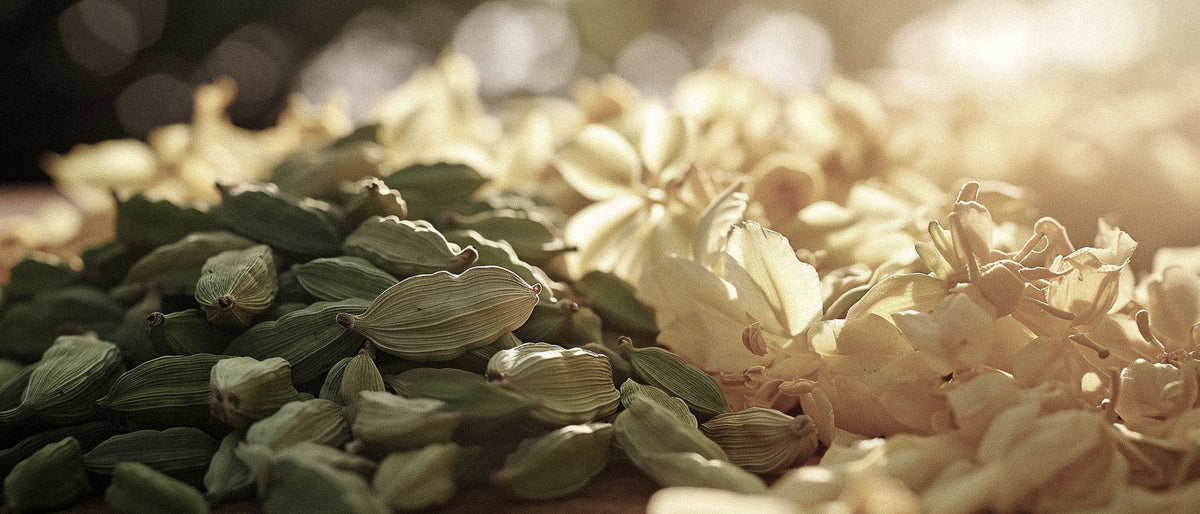
Unlocking Molecular Magic: Cardamom and Ylang-Ylang Perfume Combinations Revealed
|
|
Time to read 17 min


|
|
Time to read 17 min
In the world of perfumery, few combinations offer the intriguing contrast and complementary harmony found in the marriage of cardamom and ylang ylang. This pairing represents a fascinating dialogue between spice and flower, between East and West, between warmth and sweetness. The principles of natural perfume creation emphasize botanical ingredients like cardamom and ylang ylang, creating a foundation for some of the most compelling scent stories in modern fragrance.
The world of niche fragrance has embraced cardamom for its versatility and distinctive character, while ylang ylang has long been treasured for its lush, exotic profile. Together, they create a radiant tension—a molecular dance that perfumers have explored for generations, yet continues to yield new discoveries in contemporary perfumery.
This exploration isn’t merely artistic; it’s scientific. The interaction between these two botanicals represents a complex interplay of hundreds of volatile compounds, creating olfactory experiences that can’t be replicated through synthetic alternatives. Creating a successful niche fragrance requires understanding the molecular interplay between ingredients like cardamom and ylang ylang.
As we journey through the historical significance, chemical composition, and modern applications of this compelling duo, we’ll discover why they remain essential components in the perfumer’s palette and how they continue to shape the evolution of natural perfume in the 21st century.
The concept of niche fragrance isn’t new—it’s actually a return to perfumery’s origins. Before mass production, all perfumes were essentially “niche,” created for specific individuals or small communities. Cardamom and ylang ylang have played significant roles in this history, appearing in some of the earliest documented fragrance formulations.
Archaeological evidence reveals cardamom’s presence in perfumery dating back approximately 3,000 years. Ancient Mesopotamian texts reference cardamom-infused oils used by elites, while Egyptian hieroglyphics depict the spice’s use in religious ceremonies and personal adornment. By the Roman era, cardamom had become a prized commodity along trade routes, valued for both culinary and aromatic applications.
In India, the tradition of attar (natural perfume oils) incorporated cardamom as a key ingredient, particularly in compositions designed for royal courts. These early natural perfume creations established techniques that would influence perfumery for centuries, emphasizing the spice’s ability to add warmth and complexity to floral compositions.
Ylang ylang’s documented history begins later but is no less significant. Native to the Philippines and Indonesia, the flower (Cananga odorata) became an important element in traditional ceremonies throughout Southeast Asia. The name itself—“flower of flowers” in Tagalog—speaks to the reverence with which it was regarded. Historical records from the 16th and 17th centuries document its use in hair oils and personal fragrances throughout the region.
The modern perfume industry began to take shape in the late 19th century, coinciding with advances in extraction technology that made ingredients like ylang ylang more accessible to European perfumers. The flower quickly became a favorite among French perfume houses, appearing in formulations that would define the modern fragrance industry.
Many consumers seek natural perfumes without chemicals due to skin sensitivities or environmental concerns. This growing preference has roots in traditional perfumery practices, where botanical ingredients were used exclusively. The current revival of interest in natural perfumery represents both innovation and a return to historical techniques.
Cardamom (Elettaria cardamomum) contains over 40 volatile compounds that contribute to its distinctive aroma. The primary components include:
α-pinene, sabinene, myrcene, and limonene (monoterpene hydrocarbons)
1,8-cineole (eucalyptol) and α-terpinyl acetate (oxygenated compounds)
Linalool and linalyl acetate (alcohols and esters)
These compounds exist in different proportions depending on the cardamom’s origin, with Guatemalan cardamom typically containing higher concentrations of 1,8-cineole, while Indian varieties often feature more α-terpinyl acetate. This chemical diversity explains why cardamom from different regions can present distinct aromatic profiles, offering perfumers a range of creative possibilities.
The extraction method significantly impacts which compounds predominate in the final material. Steam distillation—the most common technique for cardamom essential oil production—tends to capture more volatile compounds while potentially losing some of the heavier molecules. CO₂ extraction, by contrast, preserves a broader spectrum of compounds, resulting in an aroma closer to the whole spice.
Ylang ylang represents one of the most chemically complex botanical perfume ingredients available to perfumers. Scientific analysis has identified over 161 volatile compounds in the flower’s essential oil, including:
p-Cresyl methyl ether and benzyl acetate (responsible for sweet, floral aspects)
Linalool and geranyl acetate (contributing fresh, citrusy notes)
Germacrene D and caryophyllene (providing woody undertones)
Methyl benzoate and benzyl benzoate (adding balsamic qualities)
This remarkable complexity explains ylang ylang’s multifaceted character in perfumery—simultaneously sweet, exotic, creamy, and slightly spicy. The best natural perfumes often feature complex combinations of spicy and floral notes like cardamom and ylang ylang, creating compositions with remarkable depth and evolution on the skin.
The extraction process for ylang ylang is particularly nuanced, with different distillation fractions yielding oils of varying characteristics:
Ylang Ylang Extra : The first fraction, collected during the initial hours of distillation, contains the highest concentration of esters and is considered the finest quality for perfumery.
Ylang Ylang I, II, and III : Subsequent fractions with progressively lower concentrations of esters and higher proportions of sesquiterpenes.
Ylang Ylang Complete : A combination of all fractions, offering a balanced representation of the flower’s complete aroma profile.
Creating effective natural perfumes without chemicals requires extensive knowledge of these extraction methods and how these natural compounds interact with human physiology.
When cardamom and ylang ylang meet in a composition, they create what perfumers call an “olfactory dialogue”—a dynamic interaction that evolves over time on the skin. This relationship forms the foundation for many successful natural perfumes without chemicals, demonstrating that botanical ingredients can create complexity comparable to synthetic formulations.
The interaction works on several levels:
Temporal Evolution : Cardamom’s volatile top notes create an immediate impression that gradually gives way to ylang ylang’s more persistent heart notes, creating a seamless transition in the fragrance’s development.
Contrast and Complement : The spicy, slightly mentholated quality of cardamom provides counterpoint to ylang ylang’s sweet, heady character, creating tension that keeps the composition interesting.
Molecular Amplification : Certain compounds present in both ingredients (like linalool) become amplified when combined, creating an effect greater than the sum of its parts.
Fixative Properties : The heavier molecules in ylang ylang help “anchor” the more volatile compounds in cardamom, extending the overall longevity of the composition.
The demand for natural perfumes without chemicals has driven innovation in how ingredients like cardamom are processed. Modern extraction techniques aim to preserve the full spectrum of aromatic compounds while eliminating potential allergens or irritants, making these natural materials more versatile for perfumers and more accessible to sensitive individuals.
Several approaches are used to capture cardamom’s aromatic compounds:
Steam Distillation : The traditional method, where steam passes through crushed cardamom pods, carrying volatile compounds that are then condensed and separated from water. While effective, this process requires significant energy input.
CO₂ Extraction : A modern technique using pressurized carbon dioxide as a solvent. This method operates at lower temperatures, preserving heat-sensitive compounds and resulting in an aroma closer to the fresh spice. It’s also considered more environmentally friendly as the CO₂ is recycled in a closed system.
Solvent Extraction : Less common for cardamom but sometimes used to create absolutes with different aromatic profiles than essential oils.
The world of niche fragrance has pioneered sustainable approaches to these extraction methods, often emphasizing quality over quantity and implementing energy-efficient technologies that reduce environmental impact.
The production of ylang ylang oil represents a particularly delicate balance of tradition and innovation:
Harvesting : Flowers must be harvested at precisely the right moment—typically early morning when their essential oil content is highest. This labor-intensive process requires skilled workers who can identify flowers at peak maturity.
Distillation : Traditional water or steam distillation remains the primary method for ylang ylang extraction. The process is carefully controlled to separate different “fractions” of the oil, each with distinct aromatic properties.
Fractionation : The distillation process for ylang ylang is unique in that it produces several grades of oil based on distillation time, with the earliest fractions (Extra and Grade I) most prized for fine perfumery.
Investing in sustainable fragrance practices helps preserve botanical diversity and traditional knowledge. Many natural perfume brands emphasize sustainable sourcing of ingredients like ylang ylang, working directly with farming communities to ensure fair compensation and environmentally responsible cultivation practices.
In modern perfumery, cardamom serves several functions:
Top Note Brilliance : Its volatile compounds create an immediate impression of freshness with spicy undertones, making it valuable for creating memorable openings.
Transition Facilitator : Cardamom effectively bridges citrus top notes and floral heart notes, creating smooth transitions between different phases of a fragrance.
Complexity Builder : Even in small amounts, cardamom adds dimensionality to simpler compositions, introducing warm, spicy facets without overwhelming other ingredients.
Signature Element : In higher concentrations, it can become a defining characteristic of a fragrance, particularly in spicy oriental compositions.
The most successful natural perfume brands balance artistic vision with scientific understanding of botanical ingredients. This knowledge allows them to create compositions that evolve beautifully on the skin while maintaining the integrity of their natural positioning.
Ylang ylang offers perfumers remarkable versatility:
Heart Note Anchor : Its rich, multifaceted character makes it an ideal centerpiece for floral compositions, providing a foundation upon which other notes can be built.
Softening Agent : The creamy aspects of ylang ylang can round out sharper notes, creating more harmonious compositions.
Exotic Signature : Its distinctive character adds an unmistakable tropical quality that transports the wearer to distant landscapes.
Emotional Trigger : Research has demonstrated ylang ylang’s ability to influence mood, making it valuable for creating fragrances designed to evoke specific emotional responses.
Many natural perfume brands emphasize sustainable sourcing of ingredients like ylang ylang, working directly with farming communities to ensure both quality and ethical production. This approach resonates with consumers who seek products aligned with their values.
The interaction between fragrance molecules and human physiology extends beyond simple olfactory pleasure. Both cardamom and ylang ylang have been studied for their effects on mood, cognition, and physiological parameters.
Research published in the International Journal of Neuroscience demonstrated that ylang ylang essential oil produced significant effects on human physiology and mood, including decreased blood pressure and heart rate, and increased alertness and attentiveness. These findings help explain the sense of calm yet focused energy many people experience when wearing fragrances containing this flower.
Cardamom has been studied for its effects on the central nervous system, with research suggesting potential benefits for cognitive function and mood regulation. A study published in the Journal of Ethnopharmacology found that cardamom extract demonstrated significant anxiolytic (anxiety-reducing) effects in laboratory models.
Finding the best natural perfumes requires understanding how different botanical ingredients interact with your skin chemistry. The same fragrance can present differently on different individuals due to variations in skin pH, temperature, and natural oils. This personalization is part of what makes natural perfumery so fascinating—each wearer experiences a unique interpretation of the composition.
As one of the world’s most expensive spices, cardamom faces several sustainability challenges:
Habitat Pressure : Traditional cardamom cultivation occurs in forest understory environments, but increasing demand has led to deforestation in some regions as farmers clear land for more intensive cultivation.
Water Usage : Cardamom requires significant water resources, creating potential strain in regions with limited supply.
Climate Vulnerability : The plant is sensitive to changes in rainfall patterns and temperature, making it vulnerable to climate change impacts.
Progressive producers are implementing more sustainable approaches, including:
Agroforestry systems that maintain forest canopy while cultivating cardamom
Organic certification programs that eliminate synthetic pesticides and fertilizers
Fair trade initiatives that ensure equitable compensation for farmers
The production of ylang ylang oil presents its own sustainability considerations:
Resource Intensity : Traditional distillation methods require significant fuel inputs, often sourced from local forests.
Economic Pressures : Market fluctuations can lead to unsustainable harvesting practices when prices are high or abandonment of trees when prices fall.
Cultural Preservation : Traditional knowledge about cultivation and processing represents important cultural heritage that can be lost as production methods modernize.
Investing in sustainable fragrance practices helps preserve botanical diversity and traditional knowledge. Forward-thinking natural perfume brands are addressing these challenges through:
Direct relationships with producer communities
Investment in energy-efficient distillation equipment
Certification programs that verify sustainable practices
Educational initiatives that preserve traditional knowledge
The concept of sustainable fragrance encompasses everything from ingredient sourcing to packaging design, creating a holistic approach to beauty that aligns with contemporary values.
Aromatherapists value ylang ylang for several evidence-based properties:
Stress Reduction : Research has demonstrated its ability to reduce cortisol levels and sympathetic nervous system activity, supporting its traditional use as a calming agent.
Blood Pressure Regulation : Clinical studies have shown that inhalation of ylang ylang essential oil can temporarily reduce blood pressure in some individuals.
Mood Enhancement : Its effects on the limbic system appear to modulate emotional responses, potentially reducing anxiety and improving mood.
These properties make ylang ylang valuable not only for its sensory qualities but also for the emotional and physiological effects it can impart to the wearer of a natural perfume.
Cardamom has been used in traditional medicine systems for centuries, with modern research supporting several applications:
Digestive Support : Its carminative properties can help ease digestive discomfort, explaining its traditional use after meals in many cultures.
Respiratory Benefits : Compounds like 1,8-cineole have demonstrated expectorant and bronchodilatory effects in research studies.
Antioxidant Activity : Cardamom contains numerous compounds with significant antioxidant properties, potentially offering protective benefits.
The therapeutic dimensions of these ingredients add another layer to their appeal in natural perfumery, allowing creators to design fragrances that offer both olfactory pleasure and potential wellness benefits.
The relationship between culinary arts and perfumery has deepened through scientific exploration:
Shared Vocabulary : Both fields analyze aromatic compounds in terms of volatility, persistence, and molecular structure.
Complementary Techniques : Extraction methods developed for culinary applications have been adapted for perfumery, and vice versa.
Sensory Analysis : Formal evaluation protocols from food science have influenced how perfumers assess and describe fragrances.
Shared Compounds : The primary aromatic compounds in cardamom—1,8-cineole and α-terpinyl acetate—contribute similar effects in both food and fragrance.
Context Perception : The same molecule can be perceived differently depending on its context—refreshing in a perfume but warming in a culinary application.
Concentration Effects : At different concentrations, cardamom’s aromatic profile shifts significantly, allowing for diverse applications in both fields.
Historical Culinary Uses : Though primarily known as a perfume ingredient today, ylang ylang has historical culinary applications in Southeast Asian traditions.
Modern Gastronomy Applications : Contemporary chefs are rediscovering ylang ylang as a flavoring agent, particularly in desserts and innovative cocktails.
Sensory Bridging : The floral-fruity aspects of ylang ylang create natural bridges between aromatic categories, making it valuable for both perfumers and chefs exploring new sensory territories.
Traditional knowledge about perfume ingredients is being preserved and expanded through modern research. This integration of historical wisdom with contemporary science creates new possibilities for both fields.
Both perfumers and chefs are increasingly approaching their crafts as multisensory experience design:
Temporal Structures : Creating experiences that evolve over time, with carefully orchestrated beginnings, middles, and endings.
Contrast and Complement : Using opposing elements to create tension and interest, such as pairing the spicy warmth of cardamom with the sweet floralcy of ylang ylang.
Memory Triggers : Deliberately incorporating elements that evoke specific memories or emotional responses.
Finding the best natural perfumes requires understanding how different botanical ingredients interact with your skin chemistry. This personalization is part of what makes natural perfumery so fascinating—each wearer experiences a unique interpretation of the composition.
The exploration of cardamom and ylang ylang in natural perfumery represents a fascinating intersection of tradition and innovation. These botanical treasures, with their complex molecular profiles and rich cultural histories, continue to inspire perfumers seeking to create authentic, meaningful olfactory experiences.
As we’ve seen, the science of natural perfumery involves sophisticated understanding of extraction methods, molecular interactions, and sensory perception. Yet equally important is the art—the intuitive, creative process of combining these materials in ways that speak to our emotions and memories.
The future of natural perfumery looks promising, with several key developments on the horizon:
Technological Advancement : Continued innovation in extraction and analysis techniques will reveal new facets of familiar materials like cardamom and ylang ylang.
Sustainability Evolution : The industry will further develop regenerative approaches to cultivation and processing that enhance rather than deplete natural resources.
Consumer Sophistication : As education becomes more accessible, consumers will develop more nuanced appreciation for the complexity and beauty of natural compositions.
Cross-Disciplinary Collaboration : Ongoing dialogue between perfumers, scientists, and practitioners in related fields will yield new insights and approaches.
The enduring appeal of cardamom and ylang ylang in perfumery speaks to something fundamental in human experience—our connection to the natural world and our desire for authentic sensory experiences. As the natural perfume market continues to evolve, these botanical allies will undoubtedly remain central to its development, offering both perfumers and consumers a window into the remarkable complexity of nature’s aromatic treasures.